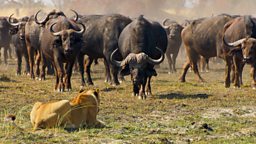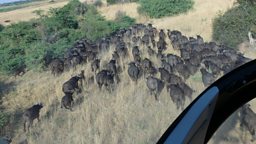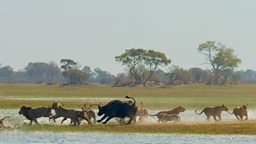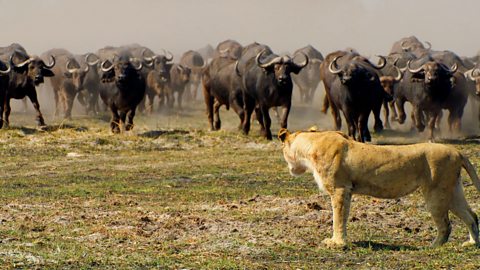Buffalo: The unsung heroes of the Delta
By Prof. Emily Bennitt, University of Botswana (Okavango Research Institute)

In some parts of the Okavango Delta, I am known as “Mma Dinare”, which translates into “Mrs. Buffalo”.
she hammered into the back of the vehicle at full speed
I didn’t spend my childhood dreaming of studying Cape buffalo, but when I was presented with an opportunity to complete my PhD in the Okavango Delta, Botswana, focusing on buffalo seemed a small price to pay. For the most part, the buffalo didn’t seem to mind my presence, trailing along behind them and occasionally finding lonely calves abandoned by inexperienced mothers.
One mother, however, took a strong exception to my somewhat strange obsession with picking up their droppings (to look at nutrient content, I promise!). To be fair, she had just given birth and saw me as a threat to her still-wet newborn. Luckily, she warned me before charging so I was able to jump into my truck and put my foot on the brake so that when she hammered into the back of the vehicle at full speed there was more of a shock than a disaster.
She took her calf back to rejoin the herd and we went our separate ways without any permanent damage – the panel-beaters in Botswana are pretty good at fixing those kinds of dents!

Over the 17 years of my academic career I have developed a deep respect for buffalo and for the other generally understudied and unappreciated herbivores that are the true backbone of the ecosystem.
unappreciated herbivores that are the true backbone of the ecosystem
The focus from safari operators, tourists and filmmakers tends to be on charismatic large carnivores that can be individually identified from their coat patterns or whisker spots and can provoke the development of a (usually one-sided) bond that people feel with these magnificent creatures. However, from an ecosystem and landscape conservation point of view, herbivores are the unsung heroes, since they not only provide food for predators, but also interact with the soil, vegetation and each other to keep the ecosystem functioning.
Cape buffalo play a critical role in the Okavango system. They are renowned for attracting lions, as one buffalo kill can provide enough meat to sate a pride, so the presence of buffalo in the Okavango likely makes life easier for the lions there. However, buffalo are also fully capable of killing lions and will do so every chance they get!
One of my favourite sightings was watching a male lion shift from a casual stroll to a flat-out dash to the safety of a termite mound when he realized that two big buffalo bulls were close on his tail.

On top of playing the role of food, buffalo aerate the soil by churning it with their hooves and their droppings provide fertilization for the regrowth of grass. Buffalo may even facilitate grazing by smaller species that can eat short grass left after buffalo have consumed and trampled taller vegetation. One of the most spectacular sights in the Okavango is the gathering of large groups of Cape buffalo, which can reach several thousand strong; a recent collaboration using wildlife documentary footage and the latest artificial intelligence techniques has documented a mega-herd of almost 4000 animals in the Mababe Depression, to the East of the Okavango.

Buffalo and other herbivores are currently thriving in the Okavango Delta, but they are at risk from changing environmental conditions. The flood pulse in the Okavango provides water during the dry season and the arrival of the flood is greeted with eager anticipation by wildlife and people alike, as it provides a lifeline in a parched landscape. However, it is when this water recedes, through evaporation and groundwater absorption, that the fresh green grass growth emerges on floodplains, supporting high numbers of buffalo and other grazing species during the harshest time of the year.
The floodplains are the most critical resource in the Okavango and their extent may well dwindle under climate change and anthropogenic development, leading to sharp declines in herbivore populations and, in due course, the predators that rely on them. Understanding the dynamics of herbivore ecology and conserving ecosystem functioning is therefore one of the best ways to ensure that wildlife, including big cats, survives for future generations. So I will continue to focus my research on buffalo and other herbivores, and I hope that I have inspired some people to consider them as more than just prey – at least I managed to convince some of the Big Cats 24/7 film crew that herbivores can be interesting!

Buffalo chase lion cubs into water
The lion cubs are forced to swim for their lives after being chased by a herd of buffalo.
